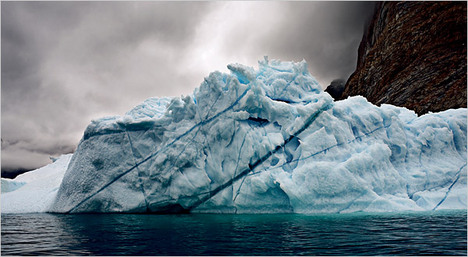 Source of captionless photo: online version of the NYT article quoted and cited below.
Source of captionless photo: online version of the NYT article quoted and cited below.
(p. 20) . . . for the residents of the frozen island, the early stages of climate change promise more good, in at least one important sense, than bad. A Danish protectorate since 1721, Greenland has long sought to cut its ties with its colonizer. But while proponents of complete independence face little opposition at home or in Copenhagen, they haven’t been able to overcome one crucial calculation: the country depends on Danish assistance for more than 40 percent of its gross domestic product. “The independence wish has always been there,” says Aleqa Hammond, Greenland’s minister for finance and foreign affairs. “The reason we have never realized it is because of the economics.”
. . .
But the real promise lies in what may be found under the ice. Near the town of Uummannaq, about halfway up Greenland’s coast, retreating glaciers have uncovered pockets of lead and zinc. Gold and diamond prospectors have flooded the island’s south. Alcoa is preparing to build a large aluminum smelter. The island’s minerals are becoming more accessible even as global commodity prices are soaring. And with more than 80 percent of the land currently iced over, the hope is that the island has just begun to reveal its riches.
. . .
In November, Greenlanders will vote on a referendum that would leverage global warming into a path to independence. The island’s 56,000 predominantly Inuit residents have enjoyed limited home rule since 1978. The proposed plan for self-rule, drafted in partnership with Copenhagen, is expected to pass overwhelmingly.
For the full story, see:
STEPHAN FARIS. “Phenomenon; Ice Free; Will Global Warming Give Greenland Its Independence?” The New York Times, Magazine Section (Sun., July 27, 2008): 20.
(Note: ellipses added.)
